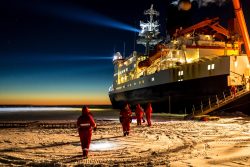
When the German icebreaker Polarstern leaves Norway’s coast on Sept. 20, it will embark on a year-long drift across the Arctic Ocean. Two University of Washington researchers are among scientists from 17 nations who will study climate change from a unique floating research platform.
The Arctic has warmed dramatically over recent decades, but observations are scarce during the ice-covered winter. The MOSAiC expedition, or Multidisciplinary drifting Observatory for the Study of Arctic Climate, will enclose the research icebreaker Polarstern in sea ice for a year, creating a drifting research platform that will pass near the North Pole.
Two UW researchers — Bonnie Light, a principal physicist at the UW’s Applied Physics Laboratory and an affiliate associate professor of atmospheric sciences, and Madison Smith, a recent UW graduate who is now doing her postdoctoral research at the UW — will join for the fifth of the six two-month legs, in summer 2020.
“This project is a once-in-a-generation endeavor,” said Light, a member of the UW Polar Science Center. “It takes a tremendous amount of commitment, resources and planning to pull off a campaign of this scope.”
The UW scientists will leave from Norway in June aboard the Swedish icebreaker Oden, then travel for about two weeks to the research base, which at that point is projected to be between 85 degrees and 90 degrees north latitude, to the north or northeast of Greenland. They will then make a final leg to reach the ship.
Following the sea ice for a full year offers unique opportunities, said Light, who studies “rotting” or melting ice. She and Smith will be part of the sea ice team and will focus on how sunlight is reflected, transmitted and absorbed by the ice cover as it melts.
Read more at UW News »
